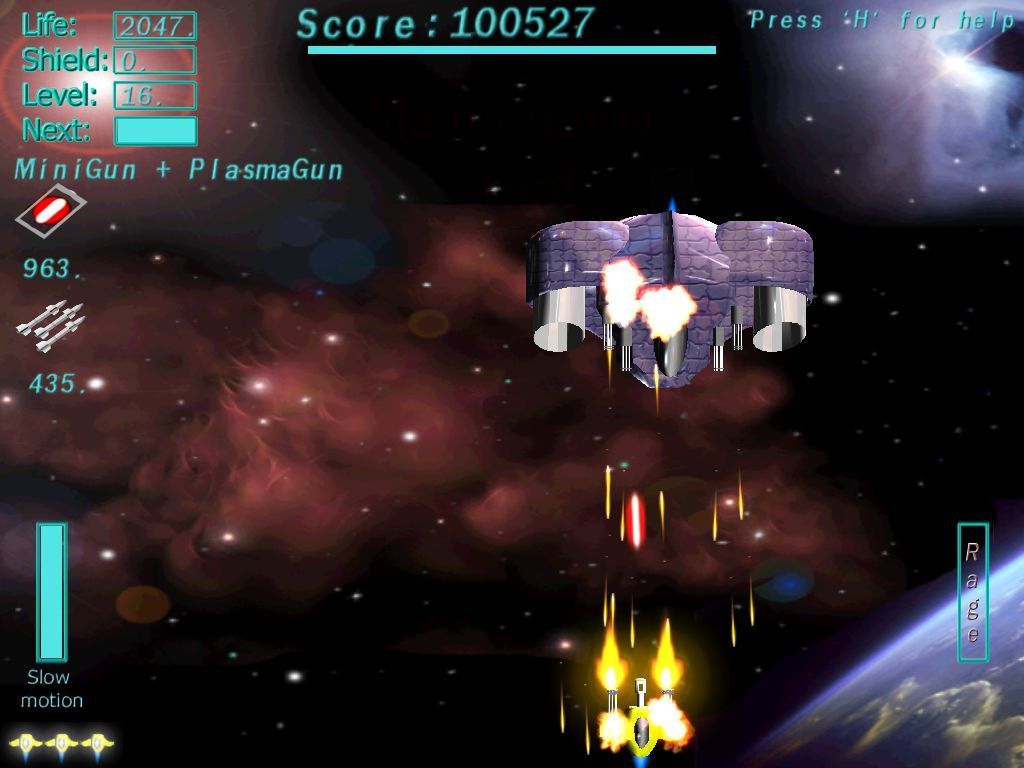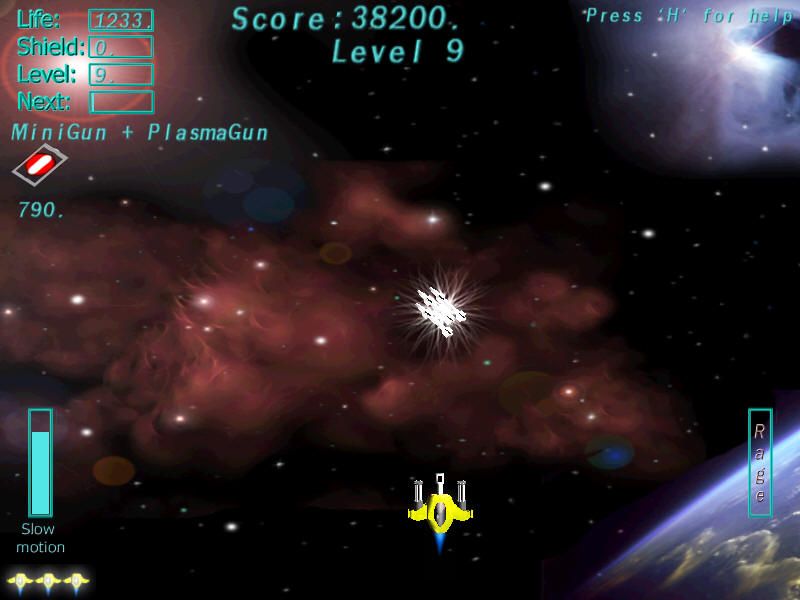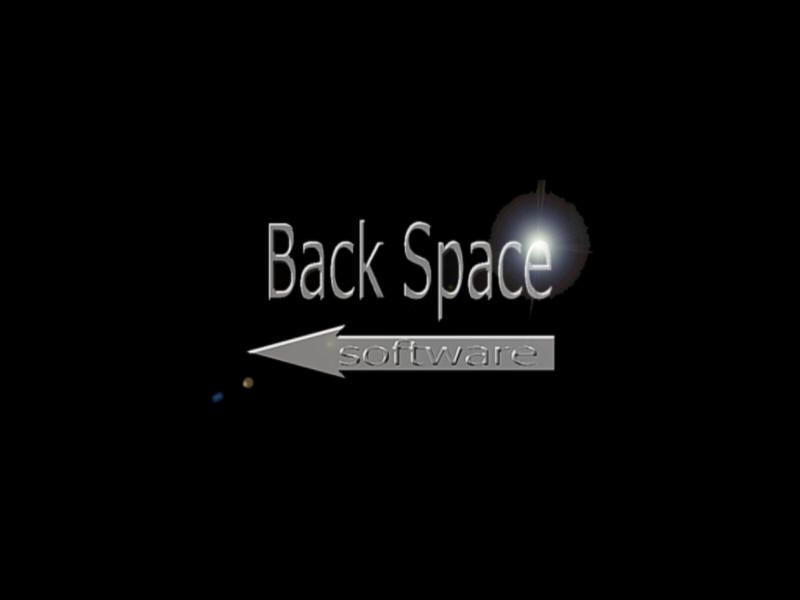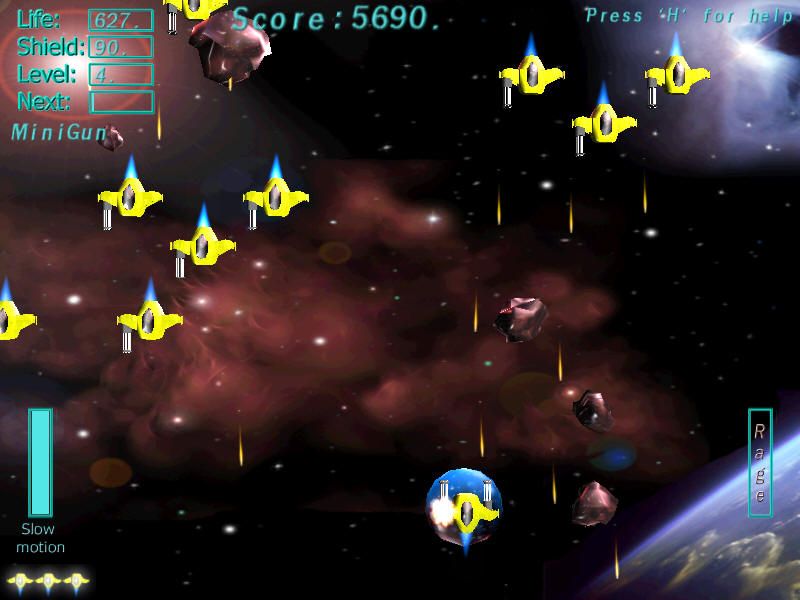Retro Replay Review
Gameplay
Back to Earth places you in the pilot’s seat of a stolen alien warship, and from the moment you engage the engines, the sense of urgency is palpable. Your primary mission is simple—navigate your way back to Earth—but the galaxy has other plans. Swirling asteroid fields, relentless enemy fighters, and massive capital ships all conspire against your return trip, forcing you to balance precision flying with aggressive combat tactics.
The controls are intuitive yet flexible, allowing you to choose between keyboard, mouse, or joystick setups. Steering the captured craft feels weighty and immersive, with subtle inertia that rewards careful course corrections. The game’s signature slow-motion drive, or bullet-time, adds another strategic layer: activate it at critical junctures to weave through dense debris or squeeze off pinpoint shots on incoming missiles.
Weapon variety keeps encounters fresh throughout the journey. Your default minigun boasts unlimited ammo but shines mainly against light fighters. Along the way, you’ll discover limited-ammo plasma guns, homing missiles, and high-powered lasers. Toggling between loadouts with the number keys 1–4 encourages you to conserve heavy ordnance for boss battles while relying on brute force for routine skirmishes.
Difficulty is customizable across three tiers—Easy, Normal, and Hard—each adjusting enemy aggressiveness, projectile speed, and the frequency of power-ups. While Easy mode offers a forgiving introduction, Hard mode becomes a nail-biter, demanding near-perfect use of bullet-time and ammunition management. Scorekeeping is local and resets with each playthrough, emphasizing skillful progression over leaderboard bragging rights.
Graphics
Visually, Back to Earth delivers a crisp, neon-lit aesthetic that highlights both the vastness and peril of deep space. Asteroid fields are rendered with sharp, angular textures, casting dynamic shadows as you streak past. Enemy ships glow with pulsating energy cores, their designs evoking a distinctly alien technology that contrasts nicely with your salvaged human weaponry.
The slow-motion sequences are particularly striking: time dilation effects blur distant stars into streaks and leave tracer trails on every projectile. These moments not only feel cinematic but also serve a functional purpose, giving you a clearer window to react. Explosions bloom in vivid oranges and purples, and debris fields shatter convincingly into fragments, enhancing the game’s overall immersion.
While the backgrounds remain relatively static—mostly star fields and distant nebulae—the developers compensate with a steady stream of environmental hazards. Glowing ice comets, collapsing space stations, and radiation storms emerge as unique set pieces. Subtle cockpit overlays, like flickering control panels and threat readouts, further ground you in the stolen vessel’s hull.
Story
Back to Earth hinges on a lean, high-stakes narrative: you’ve commandeered an alien flagship and must pilot it through hostile territory to deliver crucial intelligence to Earth command. There’s no sprawling dialogue tree or side quests—every encounter drives you closer to your homeworld or deeper into alien uncharted zones.
The urgency is amplified through occasional radio transmissions and mission updates. Between levels, you receive briefings that hint at the broader conflict: Earth’s defenses are strained, and your stolen warship may be the key to turning the tide. Though minimalistic, these snippets of lore create just enough context to make each leap through hyperspace feel consequential.
Characterization comes indirectly, through ship logs and intercepted enemy comms. You piece together the aliens’ motives and technological secrets as you pilot onward. This sparse storytelling approach ensures that gameplay remains the focus, while still delivering a satisfying sense of purpose and escalating tension with every sector you breach.
Overall Experience
Back to Earth strikes a compelling balance between arcade-style dogfighting and strategic resource management. The fast-paced action is tempered by the brain-teasing choreography of bullet-time, making every level a test of reflexes and planning. Casual players will find plenty to enjoy in lower difficulties, while hardcore pilots can hone their skills against the game’s toughest challenges.
Replayability stems from four main factors: weapon loadout experimentation, difficulty settings, optional mission routes, and the allure of shaving seconds off personal best times. Although there’s no global leaderboard, your own progression and mastery of tricky asteroid corridors provide a satisfying loop that invites repeated playthroughs.
Visually engaging and mechanically robust, Back to Earth offers an adrenaline-fueled journey that feels fresh despite its familiar premise. The absence of extraneous menus and intrusive tutorials keeps the focus where it belongs—on piloting a stolen warship through the gauntlet of an alien armada. For fans of space shooters seeking an accessible yet challenging adventure, this title is a stellar ride back to terrestrial soil.
 Retro Replay Retro Replay gaming reviews, news, emulation, geek stuff and more!
Retro Replay Retro Replay gaming reviews, news, emulation, geek stuff and more!









Reviews
There are no reviews yet.